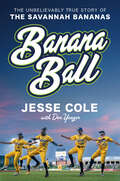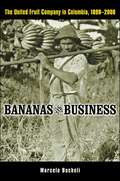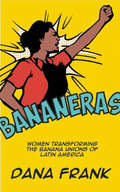- Table View
- List View
Balkan and Eastern European Countries in the Midst of the Global Economic Crisis: Balkan And Eastern European Countries In The Midst Of The Global Economic Crisis (Contributions to Economics)
by Anastasios Karasavvoglou Persefoni PolychronidouThe world is changing rapidly. The global economic crisis has called into question the political decisions that have been made by all countries for decades and has led to a re-formulation of tools and aims. Adjustments to the new situation are necessary and entail considerable economic and social costs. The Balkan and Black Sea area is an important reference point for the European and global economy. Accordingly, the study of the economic development in the area is of great interest, engaging politicians and scientists alike. Under this framework, the matter of the relation between the area's countries and the E.U., the role of the banking system and the importance of the primary sector of the economy as an important developmental factor for the countries' economies are of great importance.
Balls: The Life of Eddie Trascher, Gentleman Gangster
by Scott M. Deitche Ken SanzThe true story of the man who scammed the mob and informed the FBI for over two decades. Eddie Trascher had balls. Born in the bayou of Louisiana, Eddie learned about gambling at the side of his stepfather. Starting his career in 1950s Vegas, he moved to pre-Castro Cuba and became adept at running a casino and stealing from the mobsters who owned it. He was a regular fixture at Rat Pack–era Vegas—stealing chips from the craps table, running gambling out of his bar, and hanging around with a wild assortment of gangsters, conmen, thieves, and celebrities.By the time he moved to Clearwater, Florida, after a stint running a Los Angeles hotel for the Chicago Outfit, Eddie was the biggest bookmaker in the state. But the FBI made him an offer he couldn’t refuse: “Help us get the Mafia and we’ll let you keep bookmaking.” For the next twenty years, Eddie became the Bureau and later the Florida Department of Law Enforcement’s eyes and ears as they investigated organized crime in Florida. From the famous Donnie Brasco case to the new guard of the Tampa Mafia, Eddie was in the middle of it all. Eventually, he gave up the booking to become a professor, teaching law enforcement everything there was to know about bookmaking and running the scams. Balls is the story of the quintessential gangster, a man who didn’t make money for anyone but himself. Instead of working for the Mafia bosses, Eddie stole from right under their noses. And he lived to tell the story.
Bally Total Fitness (A): The Rise, 1962-2004
by John R. Wells Elizabeth A. Raabe Gabriel EllsworthFrom a single, modest club in 1962, Bally Total Fitness had grown to become-in management's words-the "largest and only nationwide commercial operator of fitness centers" in the United States in 2004. Bally had faced its share of challenges, but the last couple of years had proven particularly difficult. Competition in its markets had intensified, Bally's stock price had collapsed, the company had restated earnings to the chagrin of shareholders, and the U.S. Securities and Exchange Commission had begun to investigate Bally's accounting procedures. Under the direction of Paul Toback, CEO since December 2002, Bally had revisited its unique approach to pricing and selling health-club memberships, boosted the accountability of club managers for profitability, launched new efforts to help club members meet weight-loss goals, altered its marketing message, and begun to strengthen its internal control systems. Toback and his team were committed to increasing the number of Bally members and maximizing revenue per member. Would Toback's efforts restore Bally's battered stock price, stave off companies that were rumored to want to buy the company, and enable Bally to remain a major player in the industry?
Bally Total Fitness (A): The Rise, 1962-2004
by John R. Wells Elizabeth A. Raabe Gabriel EllsworthFrom a single, modest club in 1962, Bally Total Fitness had grown to become-in management's words-the "largest and only nationwide commercial operator of fitness centers" in the United States in 2004. Bally had faced its share of challenges, but the last couple of years had proven particularly difficult. Competition in its markets had intensified, Bally's stock price had collapsed, the company had restated earnings to the chagrin of shareholders, and the U.S. Securities and Exchange Commission had begun to investigate Bally's accounting procedures. Under the direction of Paul Toback, CEO since December 2002, Bally had revisited its unique approach to pricing and selling health-club memberships, boosted the accountability of club managers for profitability, launched new efforts to help club members meet weight-loss goals, altered its marketing message, and begun to strengthen its internal control systems. Toback and his team were committed to increasing the number of Bally members and maximizing revenue per member. Would Toback's efforts restore Bally's battered stock price, stave off companies that were rumored to want to buy the company, and enable Bally to remain a major player in the industry?
Baltic Beverages Holding: Competing in a Globalizing World (A)
by Rakeen Mabud Juan Alcacer Rasmus MolanderThe Finnish brewer Hartwall and the Swedish brewer Pripps had to decide how to react to the rapidly changing European political, economic, and business environment in 1989-1990.
Baltic Beverages Holding: Competing in a Globalizing World (A)
by Rakeen Mabud Juan Alcacer Rasmus MolanderThe Finnish brewer Hartwall and the Swedish brewer Pripps had to decide how to react to the rapidly changing European political, economic, and business environment in 1989-1990.
Baltic Beverages Holding: Competing in a Globalizing World (B)
by Rakeen Mabud Juan Alcacer Rasmus MolanderIn 1991, Hartwall and Pripps made the decision to found Baltic Beverages Holding (BBH) and invest in the former USSR by buying Estonia's biggest brewery, Saku.
Bamberger's: New Jersey's Greatest Store (Landmarks)
by Michael J. LisickyFor almost one hundred years, generations of New Jersey customers flocked to Bamberger's. From its grand Newark flagship to numerous suburban locations, the store was hailed for its myriad quality merchandise and its dedicated staff. Its promotional events were the highlight of every season, from the Thanksgiving Parade to elaborate Christmas festivals featuring celebrities such as Bob Hope, Carol Channing and Jerry Lewis. Though the once mighty flagship closed in 1992, Bamberger's is still fondly remembered as a retail haven. With vintage photographs, interviews with store insiders and favorite recipes, nationally renowned department store historian and New Jersey native Michael J. Lisicky brings the story of New Jersey's Greatest Store back to life.
Bamboo Gridshells
by David RockwoodThis highly illustrated text brings together two areas which have both grown in popularity in recent years: gridshells and bamboo. Bamboo is a fast-growing, naturally available, renewable resource which is quite strong and lends itself to structural applications. In this unique text, David Rockwood demonstrates the viability of bamboo as a building material and considers the advantages – as well as the challenges – of working with bamboo. Its properties, workability, connections, assembly, erection processes, structural behavior, and final use are explored in detail through a series of design-build experiments and case studies from Hawai’i and Vietnam. The only book available on the subject, Bamboo Gridshells provides a comprehensive introduction to this emerging technology which will be of interest to anyone working in the areas of sustainable or environmental design, ecological construction, low technology strategies, or alternative materials.
Banana Ball: The Unbelievably True Story of the Savannah Bananas
by Jesse ColeThe Savannah Bananas have peeled back the game of baseball and made it fun again. This is their story. For his entire childhood, Jesse Cole dreamed of pitching in the Majors. Now, he has a life in baseball that he could have only imagined: he met the love of his life in the industry; they shaped Savannah, Georgia&’s professional team into the league champion Savannah Bananas; and now the Bananas have restyled baseball itself into something all their own: Banana Ball. Fast, fun, and outrageously entertaining, Banana Ball brings fans right into the game. The Bananas throw out a first banana rather than a ball. Their first-base coach dances to "Thriller" or Britney between innings. Players run into the crowd to hand out roses. And the rules themselves are bananas: if a fan catches a foul ball it&’s an out; and players might go to bat on stilts or wearing a banana costume. And their fans absolutely love it. But the reason this team is on the forefront of a movement is less about the play on the field and more about the atmosphere that the team culture creates. For the first time in this book, Jesse reveals the ideas and experiences that allowed him to reimagine America&’s oldest sport by creating a phenomenon that is helping fans fall in love with the game all over again. This is a story that&’s bigger than baseball and bigger than the yellow tuxedo Jesse wears as the &“ringmaster&” of every game. And to understand the movement, you have to understand the story at its core. In Jesse&’s telling, it takes heart, innovation, and joy (and a bit of tropical fruit) to make something wholly original out of one of America&’s great traditions. His story is part Moneyball, part Field of Dreams, part The Greatest Showman. It is a personal story, a creativity story, and the story of a business scrapping for every success. And it has several distinct love stories—love stories like Jesse and his father, Jesse and his wife, the team and the sport of baseball, the team and the fans. This is Jesse calling his dad from the outfield after each Bananas game, and putting unending creativity into a team with the ultimate goal of bringing the Bananas to the professional ballparks he himself never got to play in. This is his story of baseball, love, leadership, and going just a bit bananas for all.
Banana Wars: Power, Production, and History in the Americas
by Steve Striffler Mark MobergOver the past century, the banana industry has radically transformed Latin America and the Caribbean and become a major site of United States-Latin American interaction. Banana Wars is a history of the Americas told through the cultural, political, economic, and agricultural processes that brought bananas from the forests of Latin America and the Caribbean to the breakfast tables of the United States and Europe. The first book to examine these processes in all the western hemisphere regions where bananas are grown for sale abroad, Banana Wars advances the growing body of scholarship focusing on export commodities from historical and social scientific perspectives. Bringing together the work of anthropologists, sociologists, economists, historians, and geographers, this collection reveals how the banana industry marshaled workers of differing nationalities, ethnicities, and languages and, in so doing, created unprecedented potential for conflict throughout Latin American and the Caribbean. The frequently abusive conditions that banana workers experienced, the contributors point out, gave rise to one of Latin America's earliest and most militant labor movements. Responding to both the demands of workers' organizations and the power of U. S. capital, Latin American governments were inevitably affected by banana production. Banana Wars explores how these governments sometimes asserted their sovereignty over foreign fruit companies, but more often became their willing accomplices. With several essays focusing on the operations of the extraordinarily powerful United Fruit Company, the collection also examines the strategies and reactions of the American and European corporations seeking to profit from the sale of bananas grown by people of different cultures working in varied agricultural and economic environments. Contributors Philippe Bourgois Marcelo Bucheli Dario Euraque Cindy Forster Lawrence Grossman Mark Moberg Laura T. Raynolds Karla Slocum John Soluri Steve Striffler Allen Wells
Banana: The Fate of the Fruit That Changed the World (Burleigh Dodds Series In Agricultural Science Ser. #40)
by Dan KoeppelA gripping biological detective story that uncovers the myth, mystery, and endangered fate of the world’s most humble fruit<P><P> To most people, a banana is a banana: a simple yellow fruit. Americans eat more bananas than apples and oranges combined. In others parts of the world, bananas are what keep millions of people alive. But for all its ubiquity, the banana is surprisingly mysterious; nobody knows how bananas evolved or exactly where they originated. Rich cultural lore surrounds the fruit: In ancient translations of the Bible, the “apple” consumed by Eve is actually a banana (it makes sense, doesn’t it?). Entire Central American nations have been said to rise and fall over the banana.<P> But the biggest mystery about the banana today is whether it will survive. A seedless fruit with a unique reproductive system, every banana is a genetic duplicate of the next, and therefore susceptible to the same blights. Today’s yellow banana, the Cavendish, is increasingly threatened by such a blight—and there’s no cure in sight. <P> Banana combines a pop-science journey around the globe, a fascinating tale of an iconic American business enterprise, and a look into the alternately tragic and hilarious banana subculture (one does exist)— ultimately taking us to the high-tech labs where new bananas are literally being built in test tubes, in a race to save the world’s most beloved fruit.
Bananas and Business: The United Fruit Company in Colombia, 1899-2000
by Marcelo BucheliFor well over a century, the United Fruit Company (UFCO) has been the most vilified multinational corporation operating in Latin America. Criticism of the UFCO has been widespread, ranging from politicians to consumer activists, and from labor leaders to historians, all portraying it as an overwhelmingly powerful corporation that shaped and often exploited its host countries. In this first history of the UFCO in Colombia, Marcelo Bucheli argues that the UFCO's image as an all-powerful force in determining national politics needs to be reconsidered. Using a previously unexplored source—the internal archives of Colombia's UFCO operation—Bucheli reveals that before 1930, the UFCO worked alongside a business-friendly government that granted it generous concessions and repressed labor unionism. After 1930, however, the country experienced dramatic transformations including growing nationalism, a stronger labor movement, and increasing demands by local elites for higher stakes in the banana export business.In response to these circumstances, the company abandoned production, selling its plantations (and labor conflicts) to local growers, while transforming itself into a marketing company. The shift was endorsed by the company's shareholders and financial analysts, who preferred lower profits with lower risks, and came at a time in which the demand for bananas was decreasing in America. Importantly, Bucheli shows that the effect of foreign direct investment was not unidirectional. Instead, the agency of local actors affected corporate strategy, just as the UFCO also transformed local politics and society.
Bananas: How the United Fruit Company Shaped the World
by Peter ChapmanIn this compelling history of the United Fruit Company, Financial Times writer Peter Chapman weaves a dramatic tale of big business, deceit, and violence, exploring the origins of arguably one of the most controversial global corporations ever, and the ways in which their pioneering example set the precedent for the institutionalized greed of today's multinational companies.The story has its source in United Fruit's nineteenth-century beginnings in the jungles of Costa Rica. What follows is a damning examination of the company's policies: from the marketing of the banana as the first fast food, to the company's involvement in an invasion of Honduras, a massacre in Colombia, and a bloody coup in Guatemala. Along the way the company fostered covert links with U.S. power brokers such as Richard Nixon and CIA operative Howard Hunt, manipulated the press in new, and stoked the revolutionary ire of Che Guevara and Fidel Castro.From the exploited banana republics of Central America to the concrete jungle of New York City, Peter Chapman's Bananas is a lively and insightful cultural history of the coveted yellow fruit, as well as a gripping narrative about the infamous rise and fall of the United Fruit Company.
Bananeras: Women Transforming the Banana Unions of Latin America
by Dana FrankThis story of Latina labor organizers is “a vital accounting of the struggles still being waged” (Margaret Randall, author of When I Look Into the Mirror and See You: Women, Terror, and Resistance).Women who pick and pack bananas in Latin America have organized themselves and gained increasing control over their unions, their workplaces, and their lives—while making gender equity central in their effort. Highly accessible and narrative in style, and written by the author of the award-winning Buy American: The Untold Story of Economic Nationalism, Bananeras recounts the history and growth of this vital movement and shows how Latin American woman workers are shaping and broadly reimagining the possibilities of international labor solidarity.Includes photographs.“A wonderful book—entertaining, enlightening, and inspiring. A unique blend of personal stories grounded in a solid analysis of the globalization of the banana economy, the rise of a regional banana workers movement, and the intense internal struggle for gender justice within Latin America’s historically male-dominated unions.” —Stephen Coats, former Executive Director, US Labor Education in the Americas Project
Banc One Corp.: Asset and Liability Management
by Peter Tufano Benjamin C. EstyBanc One's share price has been falling recently due to analyst and investor concern over the bank's heavy use of interest rate derivatives. Dick Lodge, chief investment officer in charge of the bank's investment and derivative portfolio, must recommend to the CEO a course of action to allay investors' fears and communicate to the market the reasons for Banc One's use of derivatives. The bank uses interest rate swaps to manage the sensitivity of its earnings to changes in interest rates and as attractive investment alternatives to conventional securities.
Banc One--1993
by Hugo E.R. Uyterhoeven Myra M. HartFrom a small local bank, Banc One has grown to one of the largest and most profitable banks in the United States under the leadership of its CEO, John B. McCoy. It has an impressive track record of improving the performance of its acquisitions while retaining the previous management and transferring its corporate culture. Banc One's uncommon partnership and its "share and compare" practices are viewed as key to its success. How long will it be able to sustain its stellar track record, particularly when confronted with mounting industry pressures? It has broadened its strategy, resulting in a number of organizational challenges. What lessons can be learned, particularly in terms of Banc One's acquisition approach? How is Banc One responding to the changing industry and how does it organizationally manage this change?
Banc One--1996
by James L. HeskettIn February 1995, Banc One faced the replacement of the "Uncommon Partnership," a basic operating strategy that had served it well for years. Leadership now struggled with the new protocols for replacement operating strategies.
Bancaja: Developing Customer Intelligence (A)
by F. Asis Martinez-Jerez Katherine MillerIn 1996, CEO Fernando Garcia Checa wanted to make customer analytics a part of Bancaja's new strategy. Bancaja, a savings bank based in Valencia, Spain, was expanding and wanted to exploit customer information to increase commercial effectiveness. At the same time, it was pushing for innovation in the nascent Spanish credit card market. To avoid the considerable investments of time and money that a large-scale customer relationship management (CRM) project would require, the bank decided to explore its benefits with a smaller pilot project. It appointed a CRM project team to design and implement a project focused on credit cards. Describes the challenges of the Spanish credit card market at the time, the methods for profiling credit card customers, and the variables involved in designing an optimal credit card. Concludes with a consideration of the decisions the CRM team had to make in designing the project, including whether to use conjoint analysis or implement a mini campaign.
Bancassurance in Europe
by Franco Fiordelisi Ornella RicciThis book offers a comprehensive view on bancassurancefrom its origin to future challenges and opportunities, considering the relevant changes currently interesting the financial services industry. It also provides a detailed review of theoretical and empirical literature dealing with financial conglomeration. "
Banco Compartamos: Life after the IPO
by Michael Chu Regina Garcia CuellarAfter an international IPO yielding extraordinary returns to original investors, Banco Compartamos, Mexico's leading microfinance institution, contemplates its future strategic and competing priorities: maintaining growth, defending industry, leadership, preserving social mission and meeting the expectations of a demanding capital market. Additionally, Compartamos' Co-CEOs must decide how to face the highly polarized reactions in the microfinance industry to its IPO. In the process, the case examines the history of Compartamos, from its NGO origins to its license as a full service bank; describes the competitive context of low-income sector of financing in Mexico; and reviews the decisions leading to the IPO in the Mexican Stock Exchange.
Banco Real: Banking on Sustainability
by Rosabeth Moss Kanter Ricardo Reisen de PinhoABN AMRO REAL made corporate social responsibility central to its brand, adding to customer focus and reflecting its values. Leaders developed the Bank of Value theme and implemented it through activities such as microfinance in poor communities, environmentally oriented lending products, socio-environmental screening of customers and suppliers, employee diversity, and reduction of waste and recycling. Now the fourth largest private bank in Brazil, its top leaders are assessing the first four years and wondering what to do next, as competitors adopt similar practices, reducing its competitive advantage, and as it wants to ensure its impact on social change in a country with daunting social problems.
Banco Solidario: The Business of Microfinance
by Robert E. KennedyExamines the founding and evolution of a for-profit microlending organization in Bolivia. Explores the mechanics of microlending, nonprofit and for-profit approaches to serving the informal sector, and how the industry evolves over a 15-year period.
BancoSol and Microfinance in Bolivia
by Rajiv Lal Annelena LobbBancoSol, a microfinance bank headquartered in La Paz, Bolivia, was forced to adjust its lending strategy and business model because of a regulatory change. 60% of the bank's lending portfolio would have to move to the productive sector of the Bolivian economy by 2018, and these loans would have a controlled interest rate of 11.5%. How would BancoSol meet these targets, fulfill its mission, and remain profitable?
BandPage (A)
by Karim R. Lakhani Colin Maclay Greta FriarBandPage CEO James "J" Sider is about to receive results from BandPage's targeted advertising campaign on music streaming service Rhapsody and learn whether BandPage's strategy to improve ad click through rates and generate revenue has succeeded. BandPage, which began as a Facebook app to help musicians build professional-looking pages and convert fan "likes" into revenue, has become a major hub in the online music network. BandPage has deals with upstream and downstream music partners, from streaming services to ticket sellers to merchandise companies, and has built relationships with artists by providing a one stop shop to update current band information across most major music sites simultaneously. BandPage's most recent project has been to differentiate fans by their behavior on streaming sites in order to target super fans with high priced, exclusive and/or personalized offers from artists. At a time when tensions are high between streaming services and artists who believe that they are not being fairly compensated for the use of their music, Sider is convinced that BandPage can help streaming services drive revenue growth for artists through ticket, merchandise and exclusive offer sales. If the Rhapsody data proves that BandPage's strategy is working, the potential revenue growth for BandPage and all of its partners is massive.











